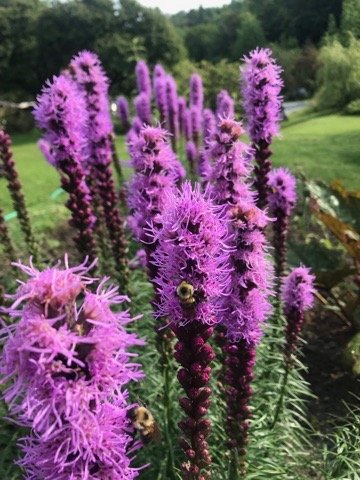 Image 1 of 2
Image 1 of 2

 Image 2 of 2
Image 2 of 2



Liatris (Compositae)
Liatris, sometimes called gayfeather or blazing star, is a genus of 30-40 species, all of which (?) are native to North America. It has become a classic in perennial landscaping and makes an excellent native pollinator attracting plant. They typically occur in praries and open meadows growing in poor, gravely soil. The more typical species available, L. spicata, makes long racemes up to 3 ft. tall covered with small, usually purple flowers that emerge from a mound of narrow leaves. There are several other species that, though less common, can make a nice addition to the landscape. Most need good drainage as the roots are prone to rot or heaving in heavy, damp soils.
AVAILABLE THIS YEAR
L. spicata ‘Floristan Violet’ - Dense spikes of purple flowers mid-summer. More tolerant of damp soil than other species.
Sold in gallon pots.
Liatris, sometimes called gayfeather or blazing star, is a genus of 30-40 species, all of which (?) are native to North America. It has become a classic in perennial landscaping and makes an excellent native pollinator attracting plant. They typically occur in praries and open meadows growing in poor, gravely soil. The more typical species available, L. spicata, makes long racemes up to 3 ft. tall covered with small, usually purple flowers that emerge from a mound of narrow leaves. There are several other species that, though less common, can make a nice addition to the landscape. Most need good drainage as the roots are prone to rot or heaving in heavy, damp soils.
AVAILABLE THIS YEAR
L. spicata ‘Floristan Violet’ - Dense spikes of purple flowers mid-summer. More tolerant of damp soil than other species.
Sold in gallon pots.
Liatris, sometimes called gayfeather or blazing star, is a genus of 30-40 species, all of which (?) are native to North America. It has become a classic in perennial landscaping and makes an excellent native pollinator attracting plant. They typically occur in praries and open meadows growing in poor, gravely soil. The more typical species available, L. spicata, makes long racemes up to 3 ft. tall covered with small, usually purple flowers that emerge from a mound of narrow leaves. There are several other species that, though less common, can make a nice addition to the landscape. Most need good drainage as the roots are prone to rot or heaving in heavy, damp soils.
AVAILABLE THIS YEAR
L. spicata ‘Floristan Violet’ - Dense spikes of purple flowers mid-summer. More tolerant of damp soil than other species.
Sold in gallon pots.
We are also propagating several other species native to the Eastern US. :
L. aspera, L. liguistylis and L scariosa var. nieuwlandii.
Check back later this year to see availability of these species.

